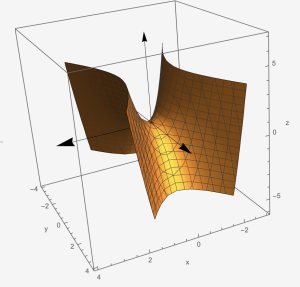Section 3.3 Partial Derivatives
3.3 Partial Derivatives
In this section, we learn what does it mean for taking derivative of a function of two variables. Recall that the first derivative of a function [latex]f(x)[/latex] at [latex]x=a[/latex] is defined as
\[f'(a)=\lim_{x\rightarrow a}\frac{f(x)-f(a)}{x-a}=\lim_{h\rightarrow0}\frac{f(a+h)-f(a)}{h}\]
if [latex]f(x)[/latex] is differentiable at [latex]x=a[/latex]. For a function of two variables, we use similar definition. The big difference is that we approach the limit at one path at a time for two dimensional space. Hence we define the derivative of a function with two variables with respect to two different directions (paths).
Definition
Let [latex]f(x,y)[/latex] be a function of two variables, [latex]x[/latex] and [latex]y[/latex]. The partial derivative of [latex]f(x,y)[/latex] with respect to [latex]x[/latex] at [latex](a,b)[/latex] is
\[f_{x}(a,b)=\lim_{x\rightarrow a}\frac{f(x,b)-f(a,b)}{x-a}=\lim_{h\rightarrow0}\frac{f(a+h,b)-f(a,b)}{h}\]
if the limit exists. This definition means that we take derivative of [latex]f(x,y)[/latex] along the path of [latex]y=b[/latex]. The partial derivative of [latex]f(x,y)[/latex] with respect to [latex]y[/latex] at [latex](a,b)[/latex] is
\[f_{y}(a,b)=\lim_{y\rightarrow b}\frac{f(a,y)-f(a,b)}{y-b}=\lim_{h\rightarrow0}\frac{f(a,b+h)-f(a,b)}{h}\]
if the limit exists. This definition means that we take derivative of [latex]f(x,y)[/latex] along the path of [latex]x=a[/latex].
Example 1: Find [latex]f_{x}(1,2)[/latex] and [latex]f_{y}(1,2)[/latex] where [latex]f(x,y)=x^{2}y-xy^{2}+2x+y+3.[/latex]
Exercise 1: Find [latex]f_{x}(2,1)[/latex] and [latex]f_{y}(2,1)[/latex] where [latex]f(x,y)=2xy^{2}+xy-x+2y-1.[/latex]
Recall in calculus I, if a function, [latex]f(x)[/latex] is differentiable over at an interval [latex]I[/latex], we can define the derivative function, [latex]f'(x)[/latex] as
\[f'(x)=\lim_{h\rightarrow0}\frac{f(x+h)-f(x)}{h}=\frac{\Delta f}{\triangle x}.\]
We do this for a function [latex]f(x,y)[/latex] of two variables.
Definition: Let [latex]f(x,y)[/latex] be a function of two variables, [latex]x[/latex] and [latex]y[/latex]. The partial derivative function of [latex]f(x,y)[/latex] with respect to [latex]x[/latex] is
\[f_{x}(x,y)=\lim_{h\rightarrow0}\frac{f(x+h,y)-f(x,y)}{h}=\frac{\partial f}{\partial x}\]
if the limit exists. This definition means that we take derivative of [latex]f(x,y)[/latex] along the path parallel to the [latex]x[/latex]-axis. We treat [latex]y[/latex]-variable as a constant and we differentiate [latex]f(x,y)[/latex] with respect to [latex]x[/latex]. The partial derivative function of [latex]f(x,y)[/latex] with respect to [latex]y[/latex] is
\[f_{y}(x,y)=\lim_{h\rightarrow0}\frac{f(x,y+h)-f(x,y)}{h}=\frac{\partial f}{\partial y}\]
if the limit exists. This definition means that we take derivative of [latex]f(x,y)[/latex] along the path parallel to the [latex]y[/latex]-axis. We treat [latex]x[/latex]-variable as a constant and we differentiate [latex]f(x,y)[/latex] with respect to [latex]y[/latex].
Example 2: Find [latex]f_{x}(x,y)[/latex] and [latex]f_{y}(x,y)[/latex] where [latex]f(x,y)=x^{2}y-xy^{2}+xy+2x^{2}-y+2.[/latex]
Exercise 2: Find [latex]f_{x}(x,y)[/latex] and [latex]f_{y}(x,y)[/latex] where [latex]f(x,y)=2x^{2}y+xy^{2}-3xy-2x+y^{2}-3.[/latex]
Example 3: Find [latex]f_{x}(x,y)[/latex] and [latex]f_{y}(x,y)[/latex] where [latex]f(x,y)=(x^{2}+xy^{2}+y^{2})^{3}.[/latex] Then find [latex]f_{x}(1,1)[/latex].
Exercise 3: Find [latex]f_{x}(x,y)[/latex] and [latex]f_{y}(x,y)[/latex] where [latex]f(x,y)=(x^{3}+x^{2}y-y^{3})^{4}.[/latex] Then find [latex]f_{y}(1,-1)[/latex].
Recall in calculus I, the first derivative of a function at [latex]x=a[/latex] gives the slope of tangent of the function at [latex]x=a[/latex]. For two variable function, we have a very similar meaning. The partial derivative of [latex]f(x,y)[/latex] with respect to [latex]x[/latex] at [latex](x,y)=(a,b)[/latex] is the slope of tangent of the curve(trace) that is the intersection of the surface [latex]f(x,y)[/latex] and [latex]y=b[/latex]. Similarly, The partial derivative of [latex]f(x,y)[/latex] with respect to [latex]y[/latex] at [latex](x,y)=(a,b)[/latex] is the slope of tangent of the curve(trace) that is the intersection of the surface [latex]f(x,y)[/latex] and [latex]x=a[/latex].
Example 4: Find [latex]f_{x}(0,\pi)[/latex] and [latex]f_{y}(0,\pi)[/latex] where [latex]f(x,y)=\text{sin}(x^{2}y+2y).[/latex]
Exercise 4: Find [latex]f_{x}(\frac{\pi}{2},0)[/latex] and [latex]f_{y}(\frac{\pi}{2},0)[/latex] where [latex]f(x,y)=\text{cos}(xy-2x).[/latex]
Definition: Let [latex]f(x_{1},x_{2},\cdots,x_{n})[/latex] be a function of [latex]n[/latex] variables. The partial derivative function of [latex]f(x_{1},\cdots,x_{n})[/latex] with respect to [latex]x_{i}[/latex] is
\[f_{x_{i}}(x_{1},\cdots,x_{n})=\lim_{h\rightarrow0}\frac{f(x_{1},...,x_{i}+h,...,x_{n})-f(x_{1},...,x_{i},...,x_{n})}{h}=\frac{\partial f}{\partial x_{i}}\]
if the limit exists. This definition means that we take derivative of [latex]f(x_{1},x_{2},\cdots,x_{n})[/latex] along the path parallel to the [latex]x_{i}[/latex]-axis. We treat variables other than [latex]x_{i}[/latex] as constants and we differentiate [latex]f(x_{1},x_{2},\cdots,x_{n})[/latex] with respect to [latex]x_{i}[/latex].
Example 5: Find [latex]f_{x}(x,y,z)[/latex], [latex]f_{y}(x,y,z)[/latex] and [latex]f_{z}(x,y,z)[/latex] where [latex]f(x,y,z)=e^{x^{2}y}+yz.[/latex]
Exercise 5: Find [latex]f_{x}(x,y,z)[/latex], [latex]f_{y}(x,y,z)[/latex] and [latex]f_{z}(x,y,z)[/latex] where [latex]f(x,y,z)=e^{xz}+xy.[/latex]
Recall in calculus I, we are able to find the second derivative of a function [latex]f(x)[/latex] by taking derivative of the first derivative, [latex]f'(x)[/latex]. At here, we have the similar approach.
Definition: Let [latex]f(x_{1},x_{2},\cdots,x_{n})[/latex] be a function of [latex]n[/latex] variables. The second partial derivative function of [latex]f(x_{1},\cdots,x_{n})[/latex] with respect to [latex]x_{i}[/latex] then [latex]x_{j}[/latex] is
\[f_{x_{i}x_{j}}(x_{1},\cdots,x_{n})=\frac{\partial f_{x_{i}}}{\partial x_{j}}=\frac{\partial}{\partial x_{j}}(\frac{\partial f}{\partial x_{i}}).\]
Example 6: Find [latex]f_{xy}(x,y,z)[/latex], [latex]f_{yx}(x,y,z)[/latex] and [latex]f_{yz}(x,y,z)[/latex] where [latex]f(x,y,z)=e^{x^{2}y}+yz.[/latex]
Exercise 6: Find [latex]f_{xy}(x,y,z)[/latex], [latex]f_{yx}(x,y,z)[/latex] and [latex]f_{xz}(x,y,z)[/latex] where [latex]f(x,y,z)=e^{xz}+xy.[/latex]
Theorem:(Clairaut's Theorem)
Suppose that [latex]f(x,y)[/latex] is defined on an open disk [latex]D[/latex] that contains the point [latex](a,b)[/latex]. If the functions [latex]f_{xy}[/latex] and [latex]f_{yx}[/latex] are continuous on [latex]D[/latex], then [latex]f_{xy}=f_{yx}[/latex].
Remark: Higher partial derivative can also be defined and we have [latex]f_{xyz}=f_{xzy}=f_{yxz}=f_{zyx}=f_{yzx}=f_{zxy}.[/latex]
Example 7: Find [latex]f_{yzx}(x,y,z)[/latex], and [latex]f_{yyx}(x,y,z)[/latex] where [latex]f(x,y,z)=e^{x}+\text{tan}(yz).[/latex]
Exercise 7: Find [latex]f_{xyz}(x,y,z)[/latex], and [latex]f_{yzz}(x,y,z)[/latex] where [latex]f(x,y,z)=e^{z}+\text{sin}(xy).[/latex]
Example 8: Find [latex]f_{y}(x,y)[/latex], and [latex]f_{x}(x,y)[/latex] where [latex]f(x,y)=y^{x}.[/latex]
Example 9: Use implicit differentiation to find [latex]\frac{\partial z}{\partial x}[/latex] and [latex]\frac{\partial z}{\partial y}[/latex] where [latex]e^{z}=xyz[/latex].
Group work:
1. Find [latex]f_{y}(x,y)[/latex], and [latex]f_{x}(x,y)[/latex] where [latex]f(x,y)=x^{y}.[/latex]
2. Use implicit differentiation to find [latex]\frac{\partial z}{\partial x}[/latex] and [latex]\frac{\partial z}{\partial y}[/latex] where [latex]\text{sin}(x)=xyz^{2}[/latex].
3. Find [latex]f_{yzx}(x,y,z)[/latex], and [latex]f_{yyx}(x,y,z)[/latex] where [latex]f(x,y,z)=e^{x}+\text{tan}(yz).[/latex]
4. Find [latex]f_{xyz}(x,y,z)[/latex], and [latex]f_{yzz}(x,y,z)[/latex] where [latex]f(x,y,z)=z^{2}yx+\text{sin}^{-1}(xy).[/latex]
5. Use implicit differentiation to find [latex]\frac{\partial z}{\partial x}[/latex] and [latex]\frac{\partial z}{\partial y}[/latex] where [latex]e^{yz}=\text{cos}(xy)[/latex].

